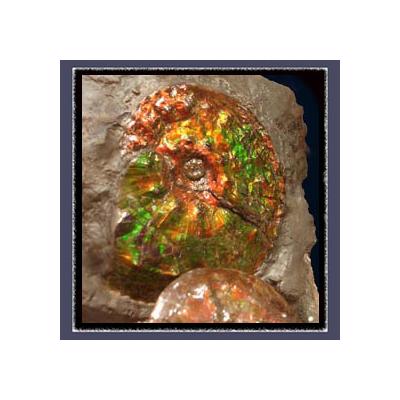
Posted in: All Things Jewelry, Jewelry History
 Ammolite (5.5 cm across at its widest) - diagenetically altered, iridescent Placenticeras ammonite shell material (nacreous aragonite, CaCO3) from the Upper Cretaceous Bearpaw Formation of the St. Mary River Valley, Alberta, Canada. Photo credit: James St. John, public domain (CC BY 2.0).
The story of ammolite extends into the recesses of time, all the way back to the Cretaceous period. At this time, the eastern slopes of the Rockies still rested below sea level, and in their place the ancient Bearpaw Sea (Western Interior Seaway) ebbed and flowed against a tropical shore.
One of the most prolific forms of life in this shallow sea were three upper cretaceous ammonites: Placenticeras meeki, Placenticeras intercalare, and Baculitus compressus.
These now-extinct cephalopods made their homes in coiled, univalve shells similar to the shells of their ancestor, the modern Nautilus. These shells were composed primarily of aragonite, the same mineral that comprises nacreous pearls.
As the cretaceous period gave way to the turbulent Mesozoic Era, the Rocky Mountains began to burst forth in the region of the Bearpaw Sea. Volcanic eruptions blanketed the region with thick layers of ash, which slowly settled across the floor of the shallow ocean.
Buried beneath the weight of more than 4km of ash, the ammonites and all the other marine animals suffocated to death. A unique spike in magnesium and iron created an anaerobic environment, which prevented the aragonite from making its usual conversion to calcium carbonate. In this mineral-rich clay called bentonite, the ammonite shells were perfectly preserved for many eons.
Subjected to intense heat and pressure, these aragonite shells were fossilized into the colorful crystal layers we know today as ammolite. As the Bearpaw region continued to emerge, glacial activity and continued geological uplift eventually exposed the treasure hidden beneath. Today, this region in Alberta, Canada, along the St. Mary River, is the only place where gem-quality ammolite is routinely collected.
by Angela Magnotti Andrews
Ammolite (5.5 cm across at its widest) - diagenetically altered, iridescent Placenticeras ammonite shell material (nacreous aragonite, CaCO3) from the Upper Cretaceous Bearpaw Formation of the St. Mary River Valley, Alberta, Canada. Photo credit: James St. John, public domain (CC BY 2.0).
The story of ammolite extends into the recesses of time, all the way back to the Cretaceous period. At this time, the eastern slopes of the Rockies still rested below sea level, and in their place the ancient Bearpaw Sea (Western Interior Seaway) ebbed and flowed against a tropical shore.
One of the most prolific forms of life in this shallow sea were three upper cretaceous ammonites: Placenticeras meeki, Placenticeras intercalare, and Baculitus compressus.
These now-extinct cephalopods made their homes in coiled, univalve shells similar to the shells of their ancestor, the modern Nautilus. These shells were composed primarily of aragonite, the same mineral that comprises nacreous pearls.
As the cretaceous period gave way to the turbulent Mesozoic Era, the Rocky Mountains began to burst forth in the region of the Bearpaw Sea. Volcanic eruptions blanketed the region with thick layers of ash, which slowly settled across the floor of the shallow ocean.
Buried beneath the weight of more than 4km of ash, the ammonites and all the other marine animals suffocated to death. A unique spike in magnesium and iron created an anaerobic environment, which prevented the aragonite from making its usual conversion to calcium carbonate. In this mineral-rich clay called bentonite, the ammonite shells were perfectly preserved for many eons.
Subjected to intense heat and pressure, these aragonite shells were fossilized into the colorful crystal layers we know today as ammolite. As the Bearpaw region continued to emerge, glacial activity and continued geological uplift eventually exposed the treasure hidden beneath. Today, this region in Alberta, Canada, along the St. Mary River, is the only place where gem-quality ammolite is routinely collected.
by Angela Magnotti Andrews
Bibliography
1. Ammonite.com. "Frequently Asked Questions." Accessed June 14, 2013. http://www.ammonite.com/faq.htm. 2. Gem Society. "Ammolite." Accessed June 14, 2013. http://www.gemsociety.org/info/gems/ammolite.htm. 3. Mac's Gems. "Canadian Ammolite." Accessed June 14, 2013. http://www.canadianammolite.com/. 4. Wikipedia. "Ammolite." Accessed June 14, 2013. http://en.wikipedia.org/wiki/Ammolite.11 years ago
10 view(s) 